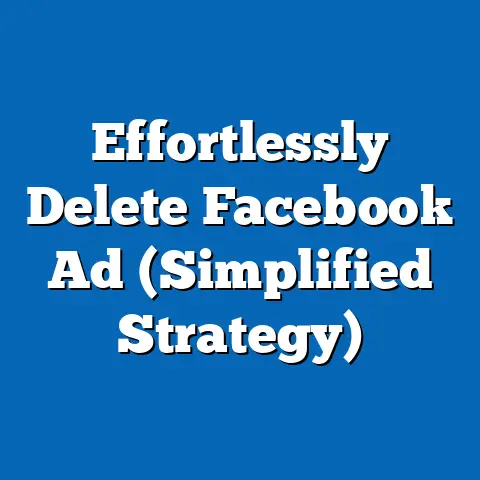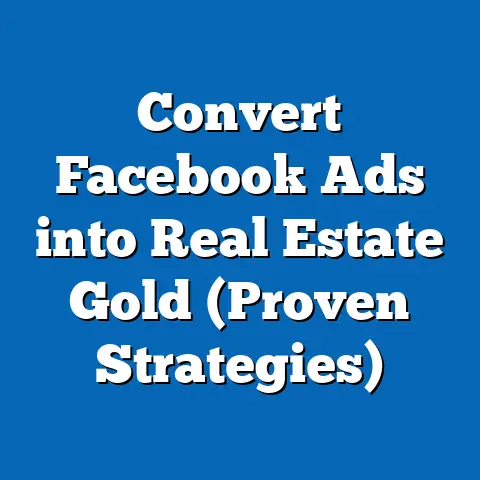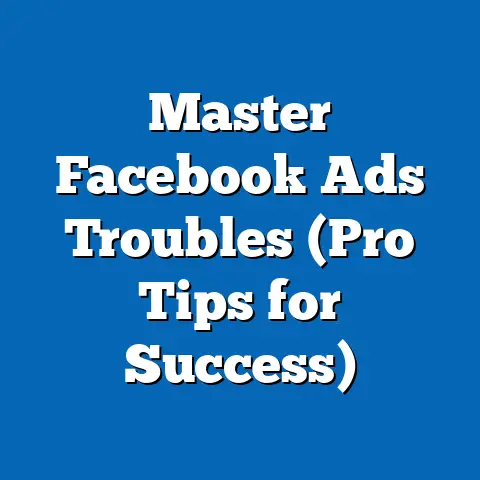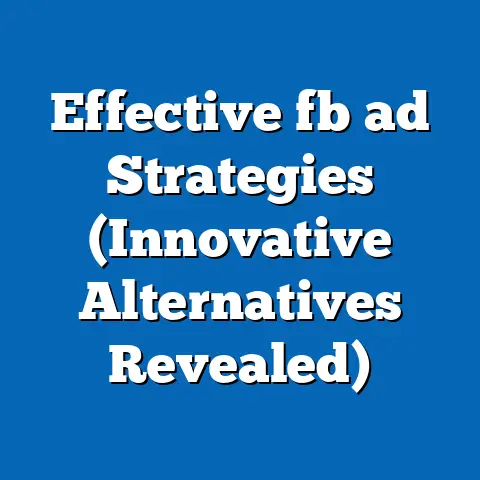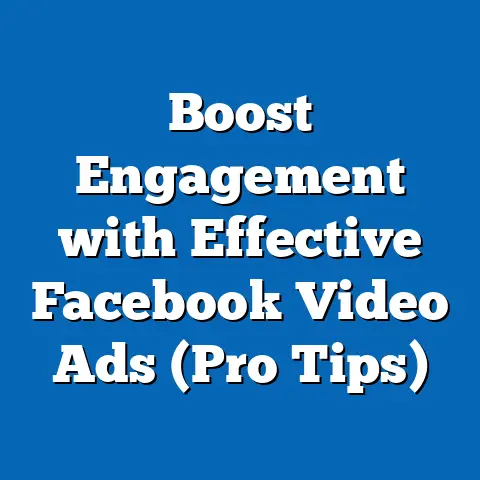Maximize Daily fb ad Spend (Proven Strategies for Success)
It’s a common trap I’ve seen countless businesses fall into: the belief that throwing more money at Facebook ads automatically translates to better results. I’ve even been there myself, early in my digital marketing career, thinking, “If I just double the budget, I’ll double the leads!” Unfortunately, it doesn’t work that way. Simply increasing your budget without a strategic approach is like driving a car with your eyes closed – you might get somewhere, but you’re more likely to crash and burn.
The truth is, maximizing your daily Facebook ad spend is about far more than just setting a high budget. It’s a delicate dance between strategic planning, meticulous data analysis, and constant optimization. It’s about understanding your audience so well you can practically read their minds, crafting ad content that stops them in their tracks, and leveraging the powerful tools Facebook provides to fine-tune your campaigns for maximum impact.
Understanding Your Audience
In my experience, the single biggest factor that determines the success or failure of a Facebook ad campaign is audience targeting. You could have the most beautifully designed ad in the world, with the most compelling copy ever written, but if you’re showing it to the wrong people, it’s all for naught. It’s like trying to sell snow to Eskimos – a complete waste of resources.
That’s why understanding your audience is absolutely paramount when it comes to maximizing your ad spend. The more precisely you can target your ads, the higher your chances of reaching people who are genuinely interested in what you have to offer, and the less money you’ll waste on showing your ads to those who aren’t.
So, how do you go about understanding your audience? Here are some key tools and methods I use:
-
Facebook Audience Insights: This is a goldmine of information about your potential customers. Audience Insights allows you to analyze the demographics, interests, behaviors, and even purchase habits of people on Facebook. You can use it to learn more about your existing customers or to discover new audiences you may not have considered. For example, I once used Audience Insights to discover that a large portion of my target audience for a fitness product was also interested in organic gardening. This led me to create ad copy that spoke to their shared interest in health and wellness, resulting in a significant boost in conversions.
-
Custom Audiences: Custom Audiences allow you to target people who have already interacted with your business, such as website visitors, email subscribers, or customers. This is incredibly powerful because these people are already familiar with your brand and are more likely to convert. I often create custom audiences based on website activity, such as people who have visited a specific product page or abandoned their shopping cart. This allows me to show them highly relevant ads that nudge them closer to making a purchase.
-
Lookalike Audiences: Lookalike Audiences are one of my favorite targeting tools. They allow you to create new audiences that are similar to your existing customers or website visitors. Facebook uses its vast database to identify people who share similar demographics, interests, and behaviors with your source audience. This is a great way to expand your reach and find new customers who are likely to be interested in your products or services. I’ve seen incredible results with lookalike audiences, often outperforming traditional demographic targeting.
-
Detailed Targeting: Facebook’s detailed targeting options allow you to narrow down your audience based on a wide range of criteria, including demographics (age, gender, location, education), interests (hobbies, activities, pages they like), and behaviors (purchase history, device usage). This level of granularity allows you to create highly targeted campaigns that resonate with specific segments of your audience.
Facebook Audience Insights: This is a goldmine of information about your potential customers. Audience Insights allows you to analyze the demographics, interests, behaviors, and even purchase habits of people on Facebook. You can use it to learn more about your existing customers or to discover new audiences you may not have considered. For example, I once used Audience Insights to discover that a large portion of my target audience for a fitness product was also interested in organic gardening. This led me to create ad copy that spoke to their shared interest in health and wellness, resulting in a significant boost in conversions.
Custom Audiences: Custom Audiences allow you to target people who have already interacted with your business, such as website visitors, email subscribers, or customers. This is incredibly powerful because these people are already familiar with your brand and are more likely to convert. I often create custom audiences based on website activity, such as people who have visited a specific product page or abandoned their shopping cart. This allows me to show them highly relevant ads that nudge them closer to making a purchase.
Lookalike Audiences: Lookalike Audiences are one of my favorite targeting tools. They allow you to create new audiences that are similar to your existing customers or website visitors. Facebook uses its vast database to identify people who share similar demographics, interests, and behaviors with your source audience. This is a great way to expand your reach and find new customers who are likely to be interested in your products or services. I’ve seen incredible results with lookalike audiences, often outperforming traditional demographic targeting.
Detailed Targeting: Facebook’s detailed targeting options allow you to narrow down your audience based on a wide range of criteria, including demographics (age, gender, location, education), interests (hobbies, activities, pages they like), and behaviors (purchase history, device usage). This level of granularity allows you to create highly targeted campaigns that resonate with specific segments of your audience.
Example:
Let’s say you’re selling handmade jewelry. You could use Facebook Audience Insights to discover that your target audience is primarily women aged 25-45 who are interested in fashion, art, and sustainable living. You could then create a custom audience of people who have visited your website and viewed your “eco-friendly” jewelry collection. Finally, you could create a lookalike audience based on your existing customers, targeting people who share similar characteristics. By combining these targeting methods, you can ensure that your ads are shown to the people who are most likely to appreciate your jewelry and make a purchase.
Key Takeaway: Audience research is the foundation of successful Facebook advertising. By understanding your audience inside and out, you can create highly targeted campaigns that maximize your ad spend and drive real results. Take the time to explore Facebook’s targeting options and experiment with different audience combinations to find what works best for your business.
Next Steps:
- Dive into Facebook Audience Insights and analyze your existing customer base.
- Create custom audiences based on your website visitors, email subscribers, and customers.
- Experiment with lookalike audiences to expand your reach and find new customers.
- Use detailed targeting to narrow down your audience based on demographics, interests, and behaviors.
Crafting Compelling Ad Content
Once you’ve identified your target audience, the next step is to create ad content that grabs their attention and compels them to take action. In today’s crowded digital landscape, you have mere seconds to make a lasting impression. If your ad is boring, generic, or irrelevant, people will simply scroll past it without a second thought.
That’s why crafting compelling ad content is crucial for maximizing your ad spend. Your ads need to be visually appealing, engaging, and relevant to your target audience. They need to tell a story, solve a problem, or offer something of value.
Here are some tips on creating ad content that converts:
-
Eye-Catching Visuals: The visual element of your ad is often the first thing people see, so it needs to be attention-grabbing. Use high-quality images or videos that are relevant to your product or service and that resonate with your target audience. Avoid using stock photos that look generic or unnatural. Instead, opt for authentic images that showcase your brand’s personality and values. I’ve found that user-generated content, such as photos or videos submitted by customers, often performs exceptionally well because it feels more genuine and relatable.
-
Persuasive Copy: Your ad copy should be clear, concise, and persuasive. Highlight the benefits of your product or service and explain how it can solve your target audience’s problems. Use strong calls to action that encourage people to take the next step, such as “Shop Now,” “Learn More,” or “Get Started.” Avoid using jargon or technical terms that your target audience may not understand. Instead, speak their language and focus on the value you’re offering.
-
A/B Testing: A/B testing is the process of testing different versions of your ad to see which one performs best. This is a critical step in optimizing your ad content and maximizing your ad spend. You can A/B test different headlines, images, body copy, and calls to action. I typically start by testing two or three different versions of my ad and then gradually refine them based on the results. A/B testing allows you to make data-driven decisions about your ad content and ensure that you’re always showing the most effective version to your target audience.
-
Ad Formats: Facebook offers a variety of ad formats, including image ads, video ads, carousel ads, and collection ads. Each format has its own strengths and weaknesses, so it’s important to experiment with different formats to see what works best for your business. For example, video ads are great for showcasing your product or service in action, while carousel ads are ideal for displaying multiple products or highlighting different features. I often use a combination of different ad formats to keep my campaigns fresh and engaging.
Eye-Catching Visuals: The visual element of your ad is often the first thing people see, so it needs to be attention-grabbing. Use high-quality images or videos that are relevant to your product or service and that resonate with your target audience. Avoid using stock photos that look generic or unnatural. Instead, opt for authentic images that showcase your brand’s personality and values. I’ve found that user-generated content, such as photos or videos submitted by customers, often performs exceptionally well because it feels more genuine and relatable.
Persuasive Copy: Your ad copy should be clear, concise, and persuasive. Highlight the benefits of your product or service and explain how it can solve your target audience’s problems. Use strong calls to action that encourage people to take the next step, such as “Shop Now,” “Learn More,” or “Get Started.” Avoid using jargon or technical terms that your target audience may not understand. Instead, speak their language and focus on the value you’re offering.
A/B Testing: A/B testing is the process of testing different versions of your ad to see which one performs best. This is a critical step in optimizing your ad content and maximizing your ad spend. You can A/B test different headlines, images, body copy, and calls to action. I typically start by testing two or three different versions of my ad and then gradually refine them based on the results. A/B testing allows you to make data-driven decisions about your ad content and ensure that you’re always showing the most effective version to your target audience.
Ad Formats: Facebook offers a variety of ad formats, including image ads, video ads, carousel ads, and collection ads. Each format has its own strengths and weaknesses, so it’s important to experiment with different formats to see what works best for your business. For example, video ads are great for showcasing your product or service in action, while carousel ads are ideal for displaying multiple products or highlighting different features. I often use a combination of different ad formats to keep my campaigns fresh and engaging.
Example:
Let’s say you’re selling a new line of organic skincare products. Instead of using a generic stock photo of a model with perfect skin, you could use a real customer testimonial video showcasing the positive results they’ve experienced using your products. Your ad copy could highlight the natural ingredients in your products and explain how they can help people achieve healthy, glowing skin without harsh chemicals. You could A/B test different headlines, such as “Get Radiant Skin Naturally” versus “Discover the Power of Organic Skincare.” By using compelling visuals, persuasive copy, and A/B testing, you can create ad content that resonates with your target audience and drives conversions.
Case Study:
One of my clients, a local coffee shop, was struggling to attract new customers through their Facebook ads. Their ads featured generic photos of coffee cups and lacked a clear call to action. I worked with them to create new ads that showcased the unique atmosphere of their shop and highlighted their specialty drinks. We also included a clear call to action, offering a free pastry with any coffee purchase. The new ads performed significantly better, resulting in a 30% increase in foot traffic to the coffee shop.
Key Takeaway: Compelling ad content is essential for capturing your target audience’s attention and driving conversions. Use high-quality visuals, persuasive copy, and A/B testing to create ads that resonate with your audience and deliver results. Don’t be afraid to experiment with different ad formats to find what works best for your business.
Next Steps:
- Brainstorm creative ad concepts that showcase your product or service in a unique and engaging way.
- Create high-quality visuals that are relevant to your target audience and that capture their attention.
- Write persuasive ad copy that highlights the benefits of your product or service and that includes a clear call to action.
- A/B test different versions of your ad to see which one performs best.
- Experiment with different ad formats to find what works best for your business.
Utilizing Facebook Ad Tools and Features
Facebook Ads Manager is a powerful platform packed with features designed to help you optimize your ad spend and achieve your marketing goals. However, many advertisers only scratch the surface of what’s possible. Understanding and utilizing these tools effectively can make a huge difference in your campaign performance.
Here are some of the key features I rely on:
-
Facebook Ads Manager: This is your central hub for creating, managing, and tracking your Facebook ad campaigns. It provides a wealth of data and insights that can help you optimize your campaigns in real-time.
-
Campaign Budget Optimization (CBO): CBO allows Facebook to automatically distribute your budget across your ad sets based on performance. This can be a great way to maximize your ad spend and ensure that you’re getting the most out of your budget. However, it’s important to note that CBO isn’t a magic bullet. You still need to have well-defined audiences and compelling ad content for it to be effective. I typically use CBO for campaigns with multiple ad sets targeting similar audiences.
-
Automated Rules: Automated rules allow you to set up triggers that automatically pause, adjust bids, or send notifications based on specific performance metrics. This can save you a lot of time and effort and help you ensure that your campaigns are always running optimally. For example, you could set up a rule to automatically pause an ad set if its cost per conversion exceeds a certain threshold.
-
Bidding Strategies: Facebook offers a variety of bidding strategies, including lowest cost, cost cap, and target cost. Each strategy has its own advantages and disadvantages, so it’s important to choose the one that’s best suited for your campaign goals. For example, if your goal is to maximize conversions, you might use the lowest cost bidding strategy. If your goal is to achieve a specific cost per conversion, you might use the cost cap bidding strategy.
Facebook Ads Manager: This is your central hub for creating, managing, and tracking your Facebook ad campaigns. It provides a wealth of data and insights that can help you optimize your campaigns in real-time.
Campaign Budget Optimization (CBO): CBO allows Facebook to automatically distribute your budget across your ad sets based on performance. This can be a great way to maximize your ad spend and ensure that you’re getting the most out of your budget. However, it’s important to note that CBO isn’t a magic bullet. You still need to have well-defined audiences and compelling ad content for it to be effective. I typically use CBO for campaigns with multiple ad sets targeting similar audiences.
Automated Rules: Automated rules allow you to set up triggers that automatically pause, adjust bids, or send notifications based on specific performance metrics. This can save you a lot of time and effort and help you ensure that your campaigns are always running optimally. For example, you could set up a rule to automatically pause an ad set if its cost per conversion exceeds a certain threshold.
Bidding Strategies: Facebook offers a variety of bidding strategies, including lowest cost, cost cap, and target cost. Each strategy has its own advantages and disadvantages, so it’s important to choose the one that’s best suited for your campaign goals. For example, if your goal is to maximize conversions, you might use the lowest cost bidding strategy. If your goal is to achieve a specific cost per conversion, you might use the cost cap bidding strategy.
Example:
Let’s say you’re running a campaign to generate leads for your business. You could use Facebook Ads Manager to set up different ad sets targeting different segments of your audience. You could then use CBO to automatically distribute your budget across the ad sets based on which ones are generating the most leads at the lowest cost. You could also set up automated rules to pause ad sets that aren’t performing well or to increase bids on ad sets that are exceeding your expectations.
Tips for Setting Up Effective Ad Campaigns:
-
Define Your Campaign Objectives: Before you start creating your campaign, it’s important to define your objectives. What do you want to achieve with your campaign? Do you want to generate leads, drive website traffic, or increase sales? Once you know your objectives, you can choose the right campaign type and bidding strategy.
-
Choose the Right Campaign Type: Facebook offers a variety of campaign types, including awareness, consideration, and conversion. Choose the campaign type that’s best suited for your objectives. For example, if your goal is to generate leads, you might choose the lead generation campaign type.
-
Set a Realistic Budget: It’s important to set a realistic budget for your campaign. Don’t overspend or underspend. Instead, set a budget that’s aligned with your objectives and that you can afford to spend over the long term.
-
Track Your Performance Metrics: It’s important to track your performance metrics regularly to see how your campaign is performing. Pay attention to key metrics such as click-through rate (CTR), conversion rate, and cost per conversion.
Define Your Campaign Objectives: Before you start creating your campaign, it’s important to define your objectives. What do you want to achieve with your campaign? Do you want to generate leads, drive website traffic, or increase sales? Once you know your objectives, you can choose the right campaign type and bidding strategy.
Choose the Right Campaign Type: Facebook offers a variety of campaign types, including awareness, consideration, and conversion. Choose the campaign type that’s best suited for your objectives. For example, if your goal is to generate leads, you might choose the lead generation campaign type.
Set a Realistic Budget: It’s important to set a realistic budget for your campaign. Don’t overspend or underspend. Instead, set a budget that’s aligned with your objectives and that you can afford to spend over the long term.
Track Your Performance Metrics: It’s important to track your performance metrics regularly to see how your campaign is performing. Pay attention to key metrics such as click-through rate (CTR), conversion rate, and cost per conversion.
Key Takeaway: Facebook offers a wealth of tools and features that can help you optimize your ad spend and achieve your marketing goals. Take the time to learn how to use these tools effectively and experiment with different settings to find what works best for your business. Don’t be afraid to leverage automation to save time and effort.
Next Steps:
- Familiarize yourself with the Facebook Ads Manager interface and explore its various features.
- Experiment with Campaign Budget Optimization (CBO) to automatically distribute your budget across your ad sets.
- Set up automated rules to pause, adjust bids, or send notifications based on specific performance metrics.
- Choose the right bidding strategy for your campaign goals.
Analyzing Results and Making Data-Driven Decisions
The final, and arguably most important, step in maximizing your Facebook ad spend is to analyze your results and make data-driven decisions. Running a Facebook ad campaign is not a “set it and forget it” activity. It requires ongoing monitoring, analysis, and optimization.
Without proper analysis, you’re essentially flying blind. You won’t know what’s working, what’s not, and where you can improve. This can lead to wasted ad spend and missed opportunities.
Here are some key performance indicators (KPIs) that I track:
- Click-Through Rate (CTR): This is the percentage of people who see your ad and click on it. A high CTR indicates that your ad is relevant and engaging to your target audience.
- Conversion Rate: This is the percentage of people who click on your ad and then take a desired action, such as making a purchase, filling out a form, or subscribing to your email list. A high conversion rate indicates that your landing page is effective and that your offer is compelling.
- Cost Per Conversion: This is the amount of money you spend to generate one conversion. A low cost per conversion indicates that your campaign is efficient and that you’re getting a good return on your investment.
- Return on Ad Spend (ROAS): This is the amount of revenue you generate for every dollar you spend on advertising. A high ROAS indicates that your campaign is profitable and that you’re maximizing your ad spend.
How to Interpret Data:
- Identify Trends: Look for patterns in your data. Are certain ad sets or ads performing better than others? Are there specific demographics or interests that are driving the most conversions?
- Compare Performance: Compare your performance metrics over time. Are your CTR, conversion rate, and cost per conversion improving or declining?
- Segment Your Data: Segment your data to gain deeper insights. For example, you could segment your data by demographics, interests, or ad placement.
- Use A/B Testing: Continue to A/B test different elements of your campaign to see what works best.
Example:
Let’s say you’re running a campaign to generate leads for your business. You notice that one of your ad sets has a high CTR but a low conversion rate. This could indicate that your ad is relevant to your target audience but that your landing page is not effective. You could then A/B test different versions of your landing page to see which one generates the most leads.
Testimonial:
“I used to just throw money at Facebook ads without really knowing what I was doing. I was getting some results, but I knew I could be doing better. After implementing the strategies outlined in this article, I was able to significantly improve my campaign performance and reduce my cost per conversion. I now have a much better understanding of my audience and how to create ads that resonate with them.” – John Smith, Small Business Owner
Key Takeaway: Analyzing your results and making data-driven decisions is critical for maximizing your Facebook ad spend. Track your performance metrics regularly, identify trends, compare performance, segment your data, and continue to A/B test different elements of your campaign.
Next Steps:
- Set up tracking for your key performance indicators (KPIs).
- Analyze your data regularly to identify trends and patterns.
- Compare your performance metrics over time.
- Segment your data to gain deeper insights.
- Continue to A/B test different elements of your campaign.
Conclusion
Maximizing your daily Facebook ad spend is a journey, not a destination. It requires a commitment to strategic planning, audience understanding, compelling content, ongoing analysis, and continuous optimization.
By implementing the proven strategies outlined in this article, you can significantly improve your campaign performance, reduce your cost per conversion, and achieve greater success with your Facebook advertising efforts. Remember, it’s not about spending more money; it’s about spending your money wisely. Good luck!

